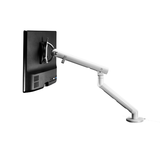
|
 |
 |
Ergonomic Monitor Arms & Stands Comparison Charts
Comparison Charts: The computer monitor is integral for working in today's offices, and is the primary visual focus for most of the hours in your working day. It is important to buy a monitor suitable for your needs. Please use this guide for some of the factors to consider when making your purchase:Monitor
Today's LCD monitors have progressed astronomically since the CRT monitors. All LCD monitors will have a good enough colour quality and image quality for your work. If you are into graphic or visual work then you may want to consider name-brand companies as their quality is usually far superior to the budget monitors.
As a rule of thumb, LCDs use 1/2 to 1/3 the energy of CRT monitors and have less heat pollution than CRTs, which will save you money and be more environmentally friendly. Speaking of the environment, LCDs emit less harmful radiation than CRT monitors, and when the life cycle of the monitor is over, it is better for the environment as there is no mercury in LCDs.
Screen size has changed a lot since the CRT monitors. LCD's most common size is 19", but most of the available models are 20.1"-22", with larger screen sizes of 24", 27" and 30". Generally the larger the screen size the better as you can see more on the screen without scrolling, which is better for your hands and arms, however if on a standard desk, try to look for a screen size no larger than 24", which is equivalent to 2 A4 pieces of paper next to each other.
Monitor Arms & Stands
The general rule for screen positioning for CRTs was to have your eyes level with the top of the monitor, and this was based on a 17" CRT monitor which had a viewing area of 16" or less. With LCD screen sizes being a lot larger then CRTs this is harder to achieve. No matter what size your monitor is you should try to avoid any unnecessary head tilting.
Try to position your eyes so that when you look at the Task Bar at the bottom of the screen or the red cross to close the application at the top right of the screen, you are not tilting your head. If you wear bifocal glasses you will need to position your monitor lower as the reading pane in the glasses is situated at the bottom half.
Monitor arms and stands are very useful for moving the monitor to the correct position for your viewing angle. Monitor stands are better for single users because even though they are height adjustable, they are still difficult to adjust with the monitor attached if the height needs to be adjusted for another user. Look for a monitor stand that can sustain the weight of your monitor, and that the surface area of the stand is greater than the surface area of the monitor base.
If you are in a multi-user environment, have little desk space, have more than one monitor, or simply want the most adjustments possible, then a monitor arm is the best solution for you. The more budget friendly monitor arms have height and tilt adjustment, but may not be adjustable from a seated position, and the range of angle adjustment may not be as great. Check to see that the monitor arm can handle the weight and size of your LCD monitor.
Another benefit the University of Utah demonstrated is that worker productivity increased with the use of two displays using a monitor arm compared to just a single display. There were 33% fewer errors, 18% faster in errorless editing of multiple tasks, and 7% faster to perform tasks.*
*Source: NEC Display Solutions, University of Utah and ATI Technologies, Productivity and Multi-Screen Displays, October 2003.